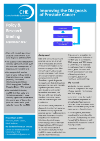Improving the diagnosis of prostate cancer
What is the best way to diagnose prostate cancer in the era of magnetic resonance imaging (MRI)?

In diagnosing prostate cancer, the objective is to find the men with clinically significant prostate cancer, who are at high risk of metastases and who benefit the most from immediate treatment.
The PROMIS study compared 2 diagnostic tests in their accuracy to detect clinically significant prostate cancer: multiparametric Magnetic Resonance Imaging (mpMRI) and TRansrectal UltraSound guided biopsy (TRUS-biopsy) versus TemPlate Mapping Biopsy (TPM-biopsy) as the reference standard.
Our economic evaluation aimed to identify the best way of using these tests in combination – diagnostic strategies - to find clinically significant prostate cancer. To do this, we built a decision analytic model using information from the PROMIS study.
The model simulates the detection rates of the various diagnostic strategies, their costs and health consequences, to understand how the strategies perform in terms of cancers detected per pound spent in diagnosis.
The model also simulates the long-term costs and health consequences of immediate diagnosis and treatment compared with monitoring. By linking the diagnosis outcomes with the long-term costs and consequences, the model evaluates the costs and health consequences of the different diagnosis strategies over the patients’ expected lifetime.
We concluded that using mpMRI first then up to two TRUS-biopsies detects more clinically significant cancers than the current way of diagnosing prostate cancer and is good value for money for the NHS. These findings are sensitive to the cost of mpMRI, TRUS-biopsy, and TPM-biopsy; the sensitivity of TRUS-biopsy after mpMRI; and the long-term outcomes of men with cancer, all of which warrant more empirical research.
More details: Improving the diagnosis of prostate cancer (PDF ![]() , 226kb)
, 226kb)
Other Policy & Research Briefing papers can be found here